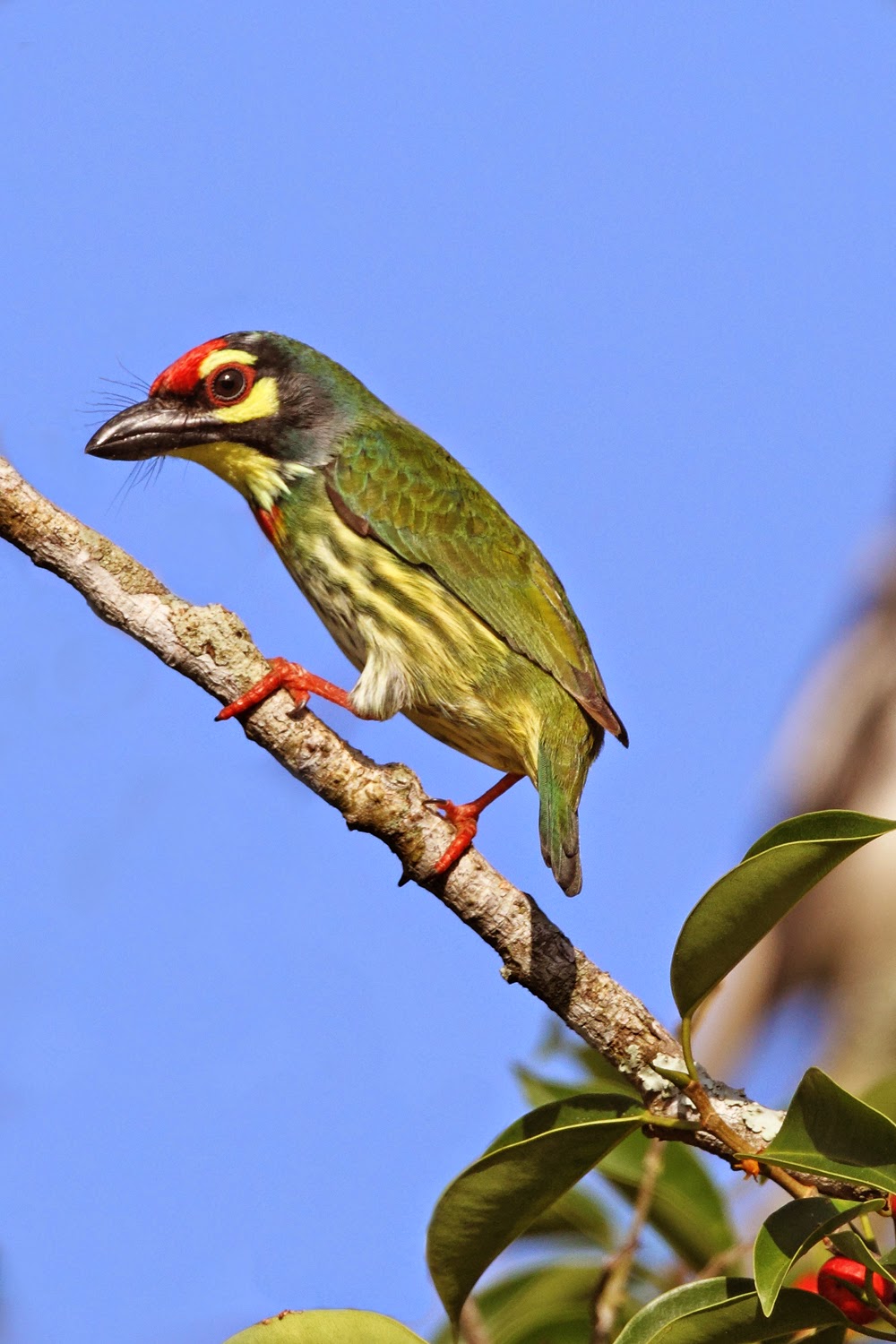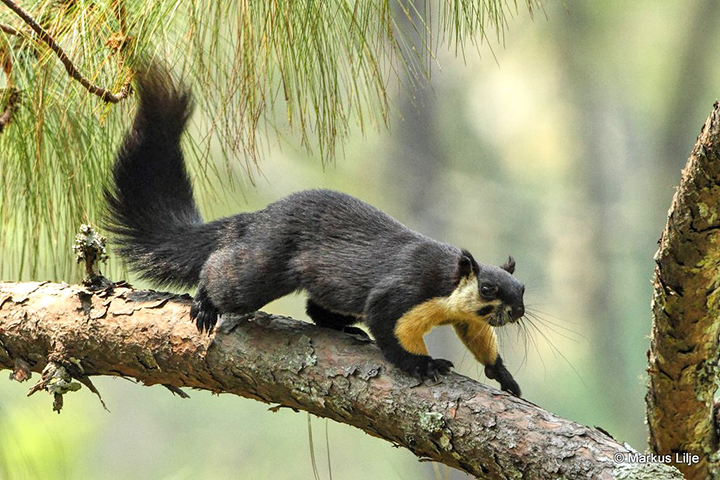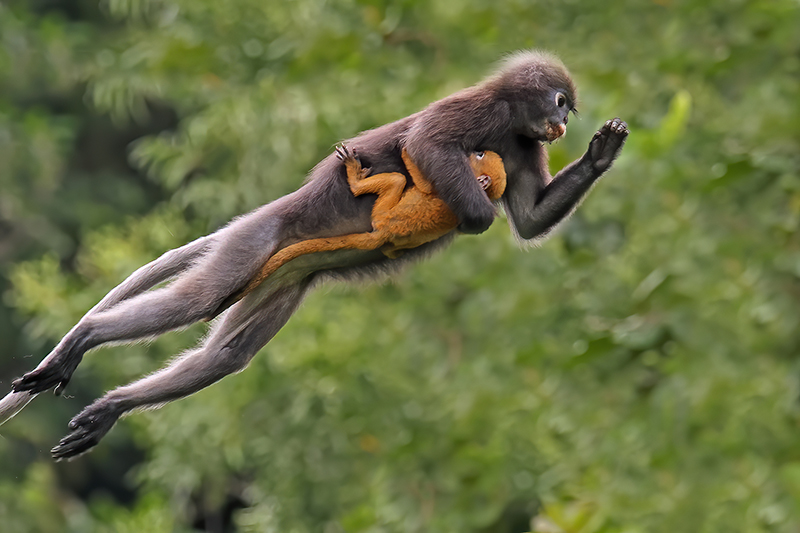Coppersmith Barbets; raising the young
The Coppersmith
Barbet (Crimson-breasted barbet) (Megalaima haemacephala) is a sparrow-sized
bird with a crimson forehead and throat, which is best known for its regular
call that is reminiscent of a coppersmith beating sheets of metal. Like other
barbets they chisel out a hole inside a tree to build their nest. They are
mainly fruit eating but will sometimes take insects, especially winged termites.
Throughout their wide range they are found in gardens, groves and sparse woodland. Habitats with trees having dead wood suitable for excavation is important. This species nest and roost in wood cavities.
The location of the described nest exemplifies the habitat of this Barbet species: located in the shadow of Gleneagles Hospital, down a busy lane with terraced shop-houses and in a dead limb of a partially decaying Laegerstromia floribunda tree.
The species is solitary, or in pairs, or small groups: larger parties occasionally congregate on abundantly fruiting Ficus trees. They are fond of sunning themselves in the morning on bare top branches of tall trees, often flitting about to sit next to each other. The flight is straight with rapid flaps.
The call is a rather metallic tuk......tuk...tuk....tuk, which is reminiscent of a copper sheet being beat, when gave the bird its name. The call is repeated monotonously for long periods, starting with a subdued tuk and building up to an even body and tempo. They are silent in winter. The beak remains shut during the each call..........a patch of bare skin on both sides of the throat inflates and colapses with each tuk, like a rubber bulb and the head is bobbed in making the call.
Coppersmith Barbets eat various berries and drupes, and the occasional insect, caught in aerial flight. Petals of flowers may be included in the diet. They eat nearly 1.5 to nearly 3 times their body weight in berries each day.
Courtship involves singing, puffing of the throat, bobbing of the head, flicking of the tail, ritual feeding and allopreening. They breed through much of the year with local variation. Both sexes excavate the nest, usually on the underside of a narrow horizontal branch.They may also roost inside the nest hole. Three or four eggs are laid and like many hole-nesting birds the incubation period is not well known but has been estimated to be about 2 weeks. Both sexes incubate and often two broods are raised in quick succession.
Photographic Criteria
The nest hole on the tree in George Town is pointing in a north-west direction. The sun rising in the east will light the branch around 9am. It is best to position the camera north to south along the edge of the road in order to get shots of the action around the nest hole. Unless it is a hazy hay I prefer the light from around 8.30 to 9.00am. Hazy sun is preferable to full sun. The parents fly in from an overhead branch from the north and this precludes landing shots. There is also not sufficient room or light intensity for incoming flight shots. The camera has to be carefully positioned to avoid light patches in the background and to get as much of the branch surrounding the hole in focus. I used a 500mm f4 lens with a 1.4x extender and shot at f8-f9 to get a sufficient depth of field.
Because Coppersmith Barbets live amongst us photographic records of their nesting are not uncommon. I had a chance to get such a record when a friend indicated there was activity in some nesting holes in a lane behind Gleneagles Hospital in George Town, Penang. Reconnaissance on 11-02-2015 showed that two of seven round holes appeared to be occupied in the early morning as the sun appeared over the horizon with respective birds peering out like horses in a horse box. Two holes in the tree were occupied in the early morning.......one member of the pair in an upstairs apartment while the nest was two stories (holes) down.
There was no apparent feeding activity but the behaviour around one hole indicated egg incubation may be occurring. I checked a week later (27-02-2015) and there was feeding activity that I followed for a number of weeks.
Two to four eggs are laid mostly a day or two apart which means that the last hatched is at a serious disadvantage in competing for food. In essence the last laid eggs are more like reserves and normally only two chicks, at most, will fledge from the nest. This species is very fastidious at keeping their house in order and faecal matter is cleared many times in a few hours. The mortality of the later chicks was soon demonstrated when an adult removed the body of a dead chick (01-03-2015) and flew off with it to be deposited away from the nest.
I visited the nest on three further occasions (08-03-2015, 16-03-2015) and each time observed regular feedings of the nest. The highest frequency was around 12 per hour but in the first 20 minutes there can be a rapid eight feedings. Fruit appeared to be the only item on the menu with no insects visible.
I first observed chick(s) on 16-03-2015
On 22-03-2015 the chick was looking at the outside world with his head outside the entrance and aggressively jabbed at the parents when they came in with, or without, fruit. about every third visit the parents would remove faecal matter from the nest.
On 22-03-2105 it was estimated the chick was 23-24 days old and therefore due to fledge in the next few days, I shot some video on this visit and it can be seen in the links below.
Life along the service lane resumed as normal. Goods were delivered, hospital workers parked their cars and reported for duty, offerings were made to remember ancestors and plants were watered, The Barbets were immune to the noise and movement beneath them.
I visited the nest again on 24-03-2015. The chick was still in place but the feeding was more relaxed. An adult appeared at the nest entrance at 7.30am and went off to gather fruit eight minutes later and soon returned for the days first feeding. The chick was more attentive to the outside world and would have a good look around. See video link B below
For a deep-seated urban environment there was quite a selection of bird species in the immediate vicinity; Mynahs and Sparrows cooled off in small fountains, the ubiquitous Yellow-vented Bulbuls and Asian Glossy Starlings foraged for fruit and insects, Koels romanced each other with their sleep-shattering calls, Dollar-birds squawked in flight, above the high-rise building Brahminy Kites and White-bellied Sea Eagles glided on thermals, nearby Olive-backed Sunbirds squeaked, a pair of Pink-necked green Pigeons buildt a nest in a nearby tree, Black-naped Orioles patrolled thee tree-tops and a female Scarlet-backed Flowerpecker stripped vegetation for nesting material.
On Thursday 26-03-2015 the chick was still in the nest and leaning further and further out. At this point evidence suggested there was a solo chick in the nest and it was very inquisitive checking out sights and sounds in all directions.The parents were feeding in a relaxed manner, which suggested fledging was not immediately imminent.
The chick would softly call to the parents and they would call from nearby branches. The light catching on the chicks throat showed the air-sac where the closed-beak call originates from.
I was away for a long weekend but heard from a fellow photographer that the chick was still in the nest on Saturday 28-03-2015. I checked when I could on Tuesday 31-03-2105 and the nest was empty.....the chick had fledged. Occasionally a parent landed on the tree as if it regretted the ending of the nesting phase. James Neoh, who had recorded several nestings said that the parents can forcibly evict a reluctant chick and guard the hole to foil a return to the nest.
Thanks to James Neoh and Praneeth.
Video links
Feeding the chick: https://vimeo.com/122922413
Chick viewing the world: https://vimeo.com/123173675












































Comments
Post a Comment